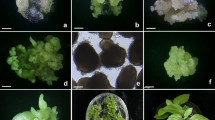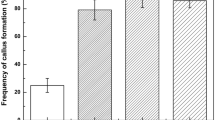Abstract
Embryogenic callus, derived from mature seeds of dune reed (Phragmites communisTrinius) was used to establish suspension culture. Green shoot-forming type and albino shoot-forming type embryogenic callus of dune reed were selected carefully by the difference of shape and color of callus growing under light and mechanically dispersed before suspending in liquid MS medium supplemented with 1.0 mg l−12,4-D. They were subcultured every 5 days to remove mucilaginous material in the early culture stage. Both fine albino and green shoot-forming cell suspension lines of dune reed were composed of rapidly growing small cell aggregates that were densely cytoplasmic and potentially embryogenic. Globular somatic embryos were continuously produced in each liquid medium containing 1.0 mg l−1 2,4-D. The cell aggregates in fine albino cell suspension line (size below 300 μm) were smaller than that of green shoot-forming cell suspension line (size between 300 and 800 μm). Following transfer to a differentiation medium, both suspension cultures formed regenerating plants with normal roots and albinotic or green shoots, respectively.
Similar content being viewed by others
References
Anonymous (1969) Wealth of Indica-raw Materials, Vol 8, Council of Scientific and Industrial Research, New Delhi, India (pp 32–34)
Biswas GCG & Zapata FJ (1992) Plant regeneration from long-term cell suspension cultures of indica rice (Oryza sativa L. cv. IR43). J Plant Physiol. 139: 523–527
Bregitzer P (1992) Plant regeneration and callus type in barley: effects of genotype and culture medium. Crop Sci 32: 1108–1112
Chang YF, Wang WC, Warfield CY, Nguyen HT & Wong JR (1991) Plant regeneration from protoplasts isolated from long-term cell cultures of wheat (Triticum aestivum L.). Plant Cell Rep. 9: 611–614
Haslam SM (1970) Variation of population type in Phragmites communis Trin. Ann. Bot. 34: 147–158
Haslam SM (1975) The performance of Phragmites communis Trin. in relation to temperature. Ann. Bot. 39: 881–888
Kenneth RG & Biddlestone AJ (1995) Engineered reed-bed systems for waste water treatment. Trends Biotechnol 13: 248–252
Krautwig B & Lorz H (1995) Single androgenetic structures of maize (Zea mays L.) for the initiation of homogeneous cell suspension and protoplast cultures. Plant Cell Rep. 14: 477–481
Machii H, Mizuno H, Hirabayashi T, Li H & Hagio T (1998) Screening wheat ecotypes for high callus induction and regeneration capability from anther and immature embryo cultures. Plant Cell Tiss. Org. Cult. 53: 67–74
Matoh T, Matsushita N & Takahashi E (1988) Salt tolerance of the reed plants Phragmites communis. Physiol. Plant. 72: 8–14
Murashige T & Skoog F (1962) A revised medium for rapid growth and bioassay with tobacco tissue cultures. Physiol. Plant. 15: 473–497
Negri MC (1996) Plants that remove contaminants from the environment. Lab. Med. 27: 36–39
Pietraface WJ & Elliott WM (1989) Culture of albino corn and sorghum. Phyton 49: 31–34
Poonawala IS, Jana MM & Nadgauda NS (1999) Factors influencing bud break and mass-scale micropropagation of three Phragmites species: P. karka, P. communis and P. australis. Plant Cell Rep. 18: 696–700
Redway FA, Vasil V & Vasil IK (1990) Characterization and regeneration of wheat (Triticum aestivum L.) embryogenic cell suspension cultures. Plant Cell Rep. 8: 714–717
Ren DT & Zhang CL (1992) Analyses of soluble protein, total and free amino acids in leaves of different ecotypes of Phragmites communis growing in the Hexi Corridor. Acta Bot. Sin. 34: 698–704
Sangwan RS & Gorenflot R (1975) In vitro culture of Phragmites tissues. Callus formation, organ differenntion and cell suspension culture. Z. Pflanzenphysiol. Bd. 75: 256–269
Straub PF, Decker MD & Gallagher JL (1988) Tissue culture and long-term regeneration of Phragmites australis (Cav.) Trin. ex Steud. Plant Cell Tiss. Org. Cult. 15: 73–78
Venketeswaran S & Mahlberg PG (1962) Proliferation of albino and pigmented genetical strains of Nicotiana in tissue culture. Physiol. Plant. 15: 639–648
Wang HL & Zhang CL (1995a) Seasonal changes of endogenous ABA and CTK in environmental adaptation of different ecotypes of reed plants. J. Environ. Sci. 7(4): 449–454
Wang HL & Zhang CL (1995b) Seasonal changes of polyamines in habitat adaptation of different ecotypes of reed plants. Oecologia 101: 119–123
Ziauddin A & Kasha KJ (1990) Long-term callus cultures of diploid barley (Hordeum vulgare): II. Effect of auxins on chromosomal status of cultures and regeneration of plants. Euphytica 48: 279–286
Author information
Authors and Affiliations
Corresponding author
Rights and permissions
About this article
Cite this article
Wang, W., Cui, S. & Zhang, C. Plant regeneration from embryogenic suspension cultures of dune reed. Plant Cell, Tissue and Organ Culture 67, 11–17 (2001). https://doi.org/10.1023/A:1011634827298
Issue Date:
DOI: https://doi.org/10.1023/A:1011634827298




